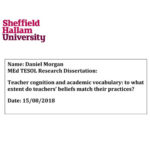Innovating EFL Teaching in Asia
Muller, T., Herder, S., Adamson, J., and Brown, P. S., (Eds). London: Palgrave MacMillan, 2012. Pp. xxiv + 301.
Reviewed by Jim Bame
Utah State University, Utah, USA
Innovating EFL Teaching in Asia is an edited volume of research in English as a Foreign Language (EFL) teaching. The book has many articles generally about teachers’ and students’ beliefs, program design and implementation, pedagogical and instructional approaches, and descriptions of various cultural, national and institutional contexts.
It contains twenty chapters (separated into five sections), a Contents, Preface, Index, and very complete and current References sections. The editors include a list of technical abbreviations specific to the Asian EFL context, short authors’ biographies, and short introductory articles for each of the book’s five sections. Theron Muller’s Introduction describes the book’s purposes and scope.
Section A, chapters 1-4, describes changing contexts of Asian EFL teaching. In “Teaching the new English curriculum,” Xi Fang clearly describes the Chinese public primary and secondary schools and outlines the new English curriculum’s (NEC) impact on instruction. Her ethnographic study analyzes teacher’s perceptions, experiences, and changes and challenges in NEC’s implementation. In the second article, “Global cultures and identities,” Will Baker argues that English teaching in EFL situations should offer learners ways to acquire multiple, changeable identities in English alongside their identity of first language and culture. He then outlines 12 intercultural awareness features and offers 6 ways to develop them in an example classroom in Thailand. In “Training the Pesantren,” Gillian Palmer and Itje Chodidja describe a British Council funded project for twelve Islamic boarding schools in East Java, Indonesia. The 1-year project’s stages, aims and purposes are described. It then discusses materials design, the pedagogical framework, and teacher development. In “Language learning styles and beliefs of EFL university students in Korea: Are they really stereotypical,” Andrew Finch studies reflection journals and other activities and presents interesting findings about typical stereotypes of Korean learners.
Section B has studies about perspectives of students’ and teachers’ about the learning process. Fumiko Murase’s “Learner autonomy in Asia” analyzes student questionnaires and teachers’ interviews about opinions concerning learner autonomy in Japan. In “Thai national culture and student’s behavior,” Chutigarn Raktham studies classroom observations, student interviews, and students watching a short film of a British classroom and found a great diversity among them. John Adamson’s “Teacher beliefs about qualifications” is a study using a free-form, 8-question interview of four Japanese and four American ex-patriot teachers to look at the diverse attitudes about levels of teachers’ qualifications. In “‘Reconceptualizing’ self as a teacher,” Rosemary Erlam and Susan Gray describe how a 4-week, pre-departure program for Malay scholarship students affects assuming identities as teachers.
Section C’s articles investigate how Western methodologies have been adapted to Asian contexts. In ”Strategy teaching in the Asian EFL oral classroom,” Wendy Lam researches oral strategy training in a Hong Kong situation with 13- and 14-year-old students. She reports on findings used by lower proficiency with more proficient learners. Philip Shigeo Brown in “Innovating a vocabulary learning strategies program” describes a vocabulary learning program in a first-year, Japanese medical program with intermediate to high-level learners in a 13-week class. Then, Theron Muller and Mark de Boer’s “Student’s use of language scaffolding” examine how formulaic language scaffolding and dynamic scaffolding — emerging from student needs – affect language use in tasks in five, second-year Japanese high school classrooms. The next article, “Innovating EFL teaching of reading,” Hongzhi Yang and Eva Bernat report on classroom observations and interviews of two teachers in a medium-sized, private university in China concerning effectiveness of reading techniques.
Section D, chapters 13-16, present investigations of young English learners. In “Curriculum innovation in ELT primary education,” Yasemin Kirkgöz reports on research done with grade 4 and 5 teachers in Turkey using questionnaires, observations, and interviews. These describe curriculum goals, teaching materials, assessment procedures, and teachers’ perceptions of a new government-mandated ELT curriculum. Then, Junko Matsuzaki Carreira’s “Motivation to learn English in elementary school” investigates 3rd – 6th graders’ motivations in a private elementary school in Tokyo with Japanese instructors. In “Adapting English picture books to an EFL context,” James Hall, Tomoko Yamazake, Chohei Takaqhashi, and Takeru Ishigame report on research on using picture books to introduce English in meaningful ways in an elementary school in rural, northern Japan. In Chapter sixteen, “Let’s speak English: Bridging the linguistic divide,” Kirsten A. Anderson and Parvathy P. Narayanan report on activity-based learning adopted in government primary schools in poor rural areas Tamil Nadu, India.
Section E has three articles about writing in EFL contexts. The first chapter, “A fluency-first approach to EFL writing,” Steven Herder and Peter Clements describe a two-year project of a fluency-first program for grades 11 and 12 in a private Japanese girls high school. In article eighteen, Huahui Zhao’s writes “Peer feedback or teacher feedback.” In it, Zhao reports on two research questions about student and teacher feedback on writing in a Chinese university in South China. In “Assessing EFL writing: Innovations through SFL,” Toshio Hisaoka argues for the use of Systemic Functional Linguistics to make assessment criteria clearer to students in the Japanese school system.
In the book’s Epilogue, “Description and evaluation of the process of creating this book,” Theron Muller and John Adamson report on the book’s creation process and give questionnaire results. They finish by echoing the book’s Introduction by challenging teacher-researchers in Asia to share the importance of local contexts in language teaching.
This very informative book presents a clear picture of how EFL is being taught in a variety of contexts at many different levels in many, specific situations. It discusses practical ideas for classrooms and presents useful research studies. It is an accessible, excellent read for teachers in both EFL and ESL situations, graduate students, materials and course designers, and researchers. The only weakness is one of its strengths. Asia is enormous; in only nineteen articles spanning only eight countries, readers can only get a quick glimpse at the innovative teaching and research being done in Asia.








